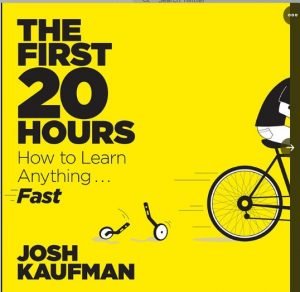
How many things do you wish to learn in your life? The book entitles “The first 20 hours to learn anything fast” is grabbing the attention of a large number of people due to its unique title. So, the author of the book is a successful business teacher and has utilized his skills in the book.
Let’s dive into the ocean of First 20 hours free book summary;
Disregard the 10,000-hour rule and imagine a scenario where it’s conceivable to take in the fundamentals of any new aptitude in 20 hours or less.
Pause for a minute to think about what number of things you need to figure out how to do. What’s on your rundown? What’s keeping you away from the beginning? It is safe to say that you are stressed over time and exertion it takes to obtain new aptitudes and the time you don’t have and energy you can’t spare?
Research recommends it takes 10,000 hours to build up new abilities or skills. In this persistent world, you rarely have that much energy and time. To exacerbate the situation, the early long periods of practicing something new are dependably the most mysterious. That is the reason it’s hard to figure out how to talk another dialect, play an instrument, hit a golf ball, or shoot incredible photographs. Therefore, it’s such a significant amount of simpler to stare at the TV or surf the web.
Detailed Review: First 20 Hours
- In The First 20 Hours, the author Josh Kaufman offers a deliberate way to deal with fast ability obtaining about how to take in any new expertise as fast as could be expected under the circumstances. His strategy demonstrates to you best practices to deconstruct complex abilities, augment gainful practice, and expel fundamental learning hindrances. By completing only 20 hours of engaged, conscious practice, you’ll go from knowing nothing to performing observably well.
If I managed to go from zero to building a simple #MachineLearning test library in about 20 hours, everyone can! Red the full story in “How I got my feet wet with machine learning with ‘The First 20 Hours’” https://t.co/Bv8mKsI82E #softwaretesting @joshkaufman pic.twitter.com/Svrbkyg1o8
— Philippe Bourgau (@pbourgau) September 9, 2019
Kaufman individually field-tested the methods described in this book. You’ll have a clear view as he builds up an individual yoga practice, composes his online PC programs. Also, instructs himself to contact type on a nonstandard keyboard, investigates the most established and most complex prepackaged game ever. He gets the ukulele and figures out how to windsurf. Here are a couple of the simple procedures he instructs: Characterize your objective execution level. Figure out what your ideal dimension of ability resembles? What you’re endeavoring to accomplish? And what you’ll have the capacity to do when you’re set? The more precise is better, hence.
Deconstruct the expertise: Most of the things we consider as aptitudes are packages of littler subskills. If you separate the subcomponents, it’s less demanding to make sense of which ones are most critical. And, therefore, practice those first.
Removing essential diversions and extreme exertion makes it a lot less demanding to take a seat. Besides, dispose of obstructions to work on work through a spotlight on conscious practice.
Make quick input circles: Getting accurate, ongoing data about how well you’re performing amid training makes it a lot less demanding to move forward.
What’s the author focused on?
Regardless of whether you need to paint a picture, dispatch a start-up, fly a plane, or juggle flaring cutting tools. The First 20 Hours will enable you to get the fundamentals of any skill in record time and what’s more, have some excellent times en route.
Josh Kaufman offers a superior way. His deliberate way to deal with quick aptitude procurement demonstrates to you proper methodologies to deconstruct complex abilities, boost gainful practice, and expel healthy learning boundaries. By finishing only 20 hours of engaged, purposeful practice, you can get the rudiments in record time and have a ton of fun as well.
What is inside the chapters?
If you don’t have time to go through all the chapters of the book, you can peruse Chapters 1-3, and you are mainly done. Instructs you what you require. Chapter 6 avoid it and read Consolidation and Interference. Chapter 7 read the Inversion model and bit on conduct settling. Whatever remains of the book are simply precedents. If you need to peruse the precedents, they will fill in as instances of deconstructing. However, you can go as far as possible of the model parts and read the surveyed parcel, which records how he deconstructed the expertise.
Pursue this, and you will wind up completing quick and can begin your next undertaking.
Thoughts
The cool thing about this book is that you understood that everything necessary is 20 hours to be truly great at something. I.e., chapter 6, who can type at 60wpm per min with a 2% mistake rate. Not me or anybody I know. This book fundamentally instructs you that all you require is 20 hours on one subject to be better at something that the general population around you is terrible at. With 20 hours, you are on the ball. So, 20 hours could be the contrast between you getting an advancement or another person. Who thinks about 10k hrs of intentional practice? Twenty hours is all you should be superior to the individual beside you.
Besides, the possibility of authority has unquestionably befuddled individuals. Also, Josh Kaufman is here to reveal to you that you can be joyfully capable on the off chance that you work at it. It’s no more extended work, but rather it requires center and devotion for 20 hours. Hence, that is the kind of time duty the average individual could make in multi-month by eliminating their TV viewing.
Anyone would find real success by perusing this in any event once and building up expertise.
So the book is a source of knowledge
So, this is an excellent book proposing a technique for grabbing the necessary abilities of an order. The creator declares that it would take 20 hours of accurately sorted out, centered exertion to learn most things to a skillful (not master) level. Besides, the book begins by telling the reader the fundamental strides of the learning strategy. The creator, at that point, portrays his endeavors at applying this technique at various orders. Hence, figuring out how to play go (the diversion), windsurfing, playing the ukulele, another kind of console, a PC programming language, and yoga.
Read Next;




